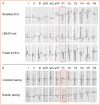The Emerging Role of Left Bundle Branch Area Pacing for Cardiac Resynchronisation Therapy
- PMID: 38173800
- PMCID: PMC10762674
- DOI: 10.15420/aer.2023.15
The Emerging Role of Left Bundle Branch Area Pacing for Cardiac Resynchronisation Therapy
Abstract
Cardiac resynchronisation therapy (CRT) reduces the risk of heart failure-related hospitalisations and all-cause mortality, as well as improving quality of life and functional status in patients with persistent heart failure symptoms despite optimal medical treatment and left bundle branch block. CRT has traditionally been delivered by implanting a lead through the coronary sinus to capture the left ventricular epicardium; however, this approach is associated with significant drawbacks, including a high rate of procedural failure, phrenic nerve stimulation, high pacing thresholds and lead dislodgement. Moreover, a significant proportion of patients fail to derive any significant benefit. Left bundle branch area pacing (LBBAP) has recently emerged as a suitable alternative to traditional CRT. By stimulating the cardiac conduction system physiologically, LBBAP can result in a more homogeneous left ventricular contraction and relaxation, thus having the potential to improve outcomes compared with conventional CRT strategies. In this article, the evidence supporting the use of LBBAP in patients with heart failure is reviewed.
Keywords: Heart failure; cardiac resynchronisation therapy; conduction system pacing; heart failure-related hospitalisation; left bundle branch area pacing.
Copyright © The Author(s), 2023. Published by Radcliffe Group Ltd.
Conflict of interest statement
Disclosure: JCD has received honoraria and is a proctor for Medtronic for left bundle branch area pacing. JER has received grants from Biosense Webster, Medtronic and MMC; consulting fees from Abbott, AtriCure, Biosense Webster and Sanofi; and has received honoraria from Biosense Webster and Boston Scientific. All other authors have no conflicts of interest to declare.
Figures





Similar articles
-
Left Bundle Branch Area Pacing for Cardiac Resynchronization Therapy: Results From the International LBBAP Collaborative Study Group.JACC Clin Electrophysiol. 2021 Feb;7(2):135-147. doi: 10.1016/j.jacep.2020.08.015. Epub 2020 Oct 28. JACC Clin Electrophysiol. 2021. PMID: 33602393
-
Rescue left bundle branch area pacing in coronary venous lead failure or nonresponse to biventricular pacing: Results from International LBBAP Collaborative Study Group.Heart Rhythm. 2022 Aug;19(8):1272-1280. doi: 10.1016/j.hrthm.2022.04.024. Epub 2022 Apr 30. Heart Rhythm. 2022. PMID: 35504539
-
Leadless Left Ventricular Endocardial Pacing and Left Bundle Branch Area Pacing for Cardiac Resynchronisation Therapy.Arrhythm Electrophysiol Rev. 2021 Apr;10(1):45-50. doi: 10.15420/aer.2020.46. Arrhythm Electrophysiol Rev. 2021. PMID: 33936743 Free PMC article. Review.
-
Complications of left bundle branch area pacing compared with biventricular pacing in candidates for resynchronization therapy: Results of a propensity score-matched analysis from a multicenter registry.Heart Rhythm. 2024 Jun;21(6):874-880. doi: 10.1016/j.hrthm.2024.02.053. Epub 2024 Feb 28. Heart Rhythm. 2024. PMID: 38428448
-
Left bundle branch area pacing in heart failure: A systematic review and meta-analysis with meta-regression.J Cardiovasc Electrophysiol. 2024 Aug;35(8):1536-1547. doi: 10.1111/jce.16304. Epub 2024 May 29. J Cardiovasc Electrophysiol. 2024. PMID: 38812213
Cited by
-
Unlocking the Potential: Angiotensin Receptor Neprilysin and Sodium Glucose Co-Transporter 2 Inhibitors for Right Ventricle Dysfunction in Heart Failure.Medicina (Kaunas). 2024 Jul 9;60(7):1112. doi: 10.3390/medicina60071112. Medicina (Kaunas). 2024. PMID: 39064541 Free PMC article. Review.
-
Recent Advances in Cardiac Resynchronization Therapy: Current Treatment and Future Direction.J Clin Med. 2025 Jan 29;14(3):889. doi: 10.3390/jcm14030889. J Clin Med. 2025. PMID: 39941560 Free PMC article. Review.
-
[New pacing strategies for heart failure].Inn Med (Heidelb). 2024 Aug;65(8):778-786. doi: 10.1007/s00108-024-01747-7. Epub 2024 Jul 5. Inn Med (Heidelb). 2024. PMID: 38967707 Review. German.
-
Current Advance, Challenges and Future Perspectives of Conduction System Pacing.Rev Cardiovasc Med. 2024 Dec 16;25(12):438. doi: 10.31083/j.rcm2512438. eCollection 2024 Dec. Rev Cardiovasc Med. 2024. PMID: 39742235 Free PMC article. Review.
-
Conduction System Pacing for CRT: A Physiological Alternative.Arrhythm Electrophysiol Rev. 2025 Feb 18;14:e04. doi: 10.15420/aer.2024.10. eCollection 2025. Arrhythm Electrophysiol Rev. 2025. PMID: 40017670 Free PMC article. Review.
References
Publication types
LinkOut - more resources
Full Text Sources
Research Materials

